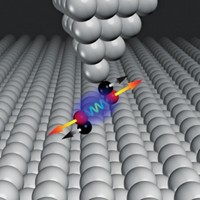Advertisement
Grab your lab coat. Let's get started
Welcome!
Welcome!
Create an account below to get 6 C&EN articles per month, receive newsletters and more - all free.
It seems this is your first time logging in online. Please enter the following information to continue.
As an ACS member you automatically get access to this site. All we need is few more details to create your reading experience.
Not you? Sign in with a different account.
Not you? Sign in with a different account.
ERROR 1
ERROR 1
ERROR 2
ERROR 2
ERROR 2
ERROR 2
ERROR 2
Password and Confirm password must match.
If you have an ACS member number, please enter it here so we can link this account to your membership. (optional)
ERROR 2
ACS values your privacy. By submitting your information, you are gaining access to C&EN and subscribing to our weekly newsletter. We use the information you provide to make your reading experience better, and we will never sell your data to third party members.
Analytical Chemistry
SERS Hot Spots Probed
ACS Meeting News: Imaging shows larger-than-expected SERS-analyzable spots on nanoparticles
by Celia Henry Arnaud
August 24, 2010
| A version of this story appeared in
Volume 88, Issue 35
Superresolution imaging by single-molecule surface-enhanced Raman spectroscopy (SERS) shows that SERS-active sites called "hot spots" on metal nanoparticles may be larger than previously thought. Katherine A. Willets, an assistant chemistry professor at the University of Texas, Austin, presented her group's results at the American Chemical Society meeting in Boston and in a recent paper (Nano Lett., DOI: 10.1021/nl102559d). Their findings could help scientists reach a deeper level of understanding about the way single-molecule SERS works.
Only certain regions of nanoparticle SERS substrates are able to generate single-molecule SERS spectra. Characterizing these hot spots is difficult because both the molecule being analyzed and the hot spot in which it is found are smaller than the diffraction limit of light. To overcome this challenge, Willets and grad student Sarah M. Stranahan pinpointed the location of individual rhodamine 6G molecules by fitting their SERS emission to a two-dimensional Gaussian function, a method they borrowed from superresolution fluorescence microscopy.
"We've known for a number of years that the intensity of the molecules sitting in the hot spots fluctuates," Willets says. "What we see now is that these intensity fluctuations are coupled to motion of the molecule on some level."
They find that these intensity fluctuations correlate with motion of the molecule over distances of up to 100 nm, whereas the hot spots have been assumed to be closer to the size of an individual molecule, about 10 nm.
"One of the main difficulties in SERS is lack of ability to locate precisely the source of the effect as a function of geometry," says John R. Lombardi, a Raman expert at City College of New York. "Willets' work presents an ideal opportunity to elucidate the true nature of SERS."
The findings suggest that "our models of single-molecule SERS are not capturing the hot-spot properties properly," says George C. Schatz, a chemistry professor at Northwestern University. The study makes it "clear that our notion of what is a hot spot needs refinement."






Join the conversation
Contact the reporter
Submit a Letter to the Editor for publication
Engage with us on Twitter